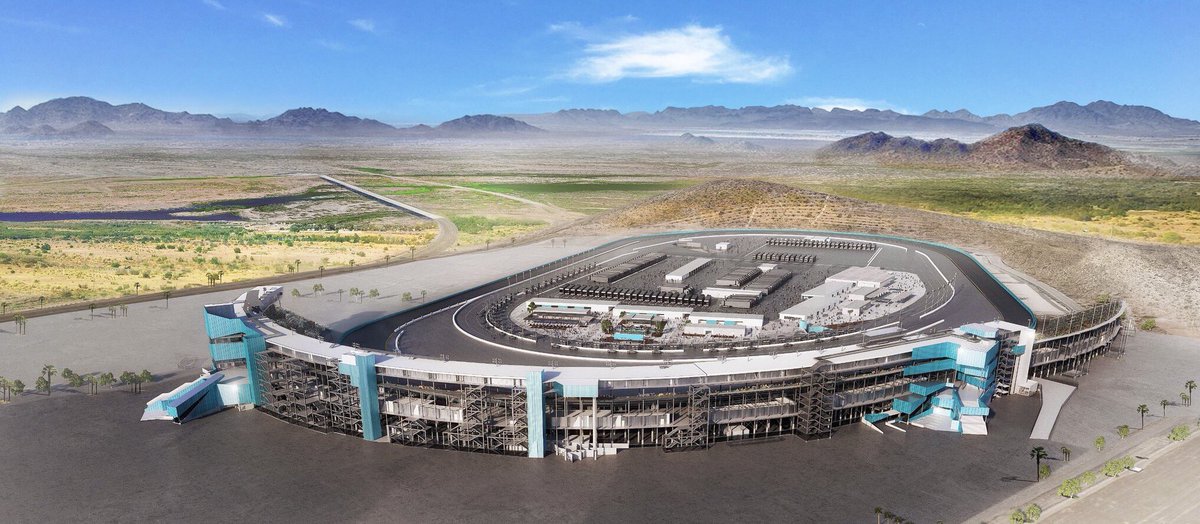- February 2, 2017
- Posted by: SportsV
- Categories: Home News, Industry News, News

The US$178m reconstruction of Phoenix International Raceway (PIR) will give fans unprecedented driver access at event level and put them ‘on top of the action’ in a new 45,000-seat grandstand. Globally-recognised architecture firm, ROSSETTI, is teaming up with Phoenix firm, DLR Group, on the modernisation project.
The Phoenix upgrades represent the first major renovation of an International Speedway Corporation (ISC) facility since the US$400m Daytona Rising project. Some features, such as the two new sponsor-driven gate entrances in Phoenix are similar to the improvements at Daytona International Speedway.
The upgrades extend to the Busch Garage, a new sports bar and live music venue anchoring a revamped midway. In addition, a new premium club along Turn 3 is part of a reconfigured suite level that will add about a dozen suites to the 46 existing units.

The biggest piece of the project is the relocation of the start/finish line to along what was originally Turn 2, a dogleg stretch known for the “divebombing” tactics drivers use to jockey for position on the track, according to raceway President Bryan Sperber.
The existing Bobby Allison Grandstand cradling Turn 2 will effectively double in size with all new chairback seats. The renovations call for the old frontstretch to be torn down, where it will remain open space.
Total capacity will remain at around 51,000, which includes a large hill with room for 5,000 people at the end opposite of the grandstand, Sperber said.
For the first time since the track opened in 1964, every seat in the new and improved Allison Grandstand will have an unobstructed view, a critical part of the fan experience that track developers paid less attention to in the past, said Derek Muldowney, ISC’s President of Design and Development.
Muldowney confirmed:
It’s something we struggle with, especially at a lot of the older short tracks. I think we’ve got it figured out here.
As part of its research, ISC talked with NASCAR officials and drivers to determine the best location for moving the start/finish line. It made sense to move it to Turn 2, a unique spot in racing, Sperber said, and added:
We reconfigured the track [surface] about six years ago and it opened up that part of the track for some daredevil passing. They’ll come down onto the apron and go five to six wide. At times, it’s a free-for-all. It’s very challenging for the drivers and a lot of fun for the fans.
Officials also studied sun patterns as part of the seating reconfiguration. Most patrons will have the sun at their backs for the races in March and November, Muldowney said.

In the infield, the garage area will be reconfigured for fans paying an upcharge to interact with their favourite drivers, separated by a short fence. The design is still being worked out but “nowhere on the NASCAR circuit will fans be able to get closer than what we’ll be able to provide,” Sperber said.
A pedestrian tunnel underneath the track connecting the grandstand to the infield will open next year. It initially was built as part of the track resurfacing project, falling in line with the long-term master plan for improvements.
Officials in Phoenix are developing “canyons” as new entrances to the track, similar to Daytona’s new sponsored “injectors”, and the new concessions, restrooms, elevators and escalators for PIR also mirror what ISC did at its flagship facility.
Muldowney said:
This project has been in the planning stages for a long time, running parallel to what we did in Daytona. We figured out a lot of things that worked really well [in Daytona] and wanted to translate those elements to Phoenix.
Construction is due to get underway this month, with completion slated for November 2018.
Article adapted from a blog posted on ROSSETTI’s website, which had been dervived from an article that first appeared in Sports Business Journal by Don Muret. To be directed to the original article, click here.
Images, courtesy: ROSSETTI / DLR Group

